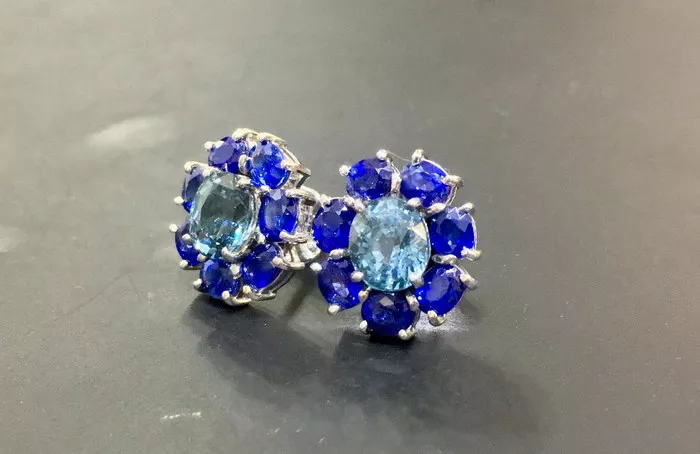Diamond studs are celebrated for their timeless elegance and captivating sparkle, but one often overlooked aspect that profoundly influences their beauty is color. While traditionally prized for their clarity and brilliance, the color of diamonds plays a crucial role in determining their overall appearance, value, and how well they complement the wearer’s complexion and style. This comprehensive guide explores the importance of color in diamond stud earrings, providing insights into how diamond color is graded, its impact on aesthetics, and practical considerations when selecting the perfect pair.
Understanding Diamond Color Grading
Diamonds are graded on a color scale established by the Gemological Institute of America (GIA), ranging from D (colorless) to Z (light yellow or brown). The color grade primarily assesses the presence of any tint in the diamond, with D being the highest grade for colorless stones and Z indicating noticeable color.
Factors Influencing Diamond Color
Natural Variation: Diamonds form under immense pressure and heat deep within the Earth, resulting in a variety of natural colors. While most diamonds are traditionally white or colorless, others can exhibit shades of yellow, brown, or even rare hues like blue, pink, or green.
Grading Criteria: Diamond color is assessed based on how noticeable the tint is to a trained gemologist under controlled lighting conditions. The grading process considers the diamond’s hue (color), tone (lightness or darkness), and saturation (intensity of color).
Impact on Value: The rarity of colorless diamonds (D-F) makes them highly valued and often more expensive than diamonds with faint to noticeable color (G-Z). However, colored diamonds with intense hues can also command high prices due to their rarity and unique appeal.
Aesthetic Considerations
The color of diamond studs significantly influences their aesthetic appeal and how they complement various skin tones and jewelry styles. Understanding how different colors interact with light and appear against the skin can help you choose diamond studs that enhance your overall look.
See Also: Where Should I Sell My Diamond Ring?
1. Choosing the Right Color Grade
Colorless (D-F): These diamonds are prized for their icy-white appearance, allowing maximum light reflection and brilliance. They are ideal for achieving a classic, elegant look and can complement any outfit with their neutral tone.
Near Colorless (G-J): Slightly warmer in tone than colorless diamonds, near colorless diamonds can offer excellent value while still appearing white to the naked eye. They can provide a beautiful balance between quality and budget.
Faint to Light Yellow (K-Z): Diamonds in this range may exhibit noticeable yellow or brown hues. While some prefer the warmth these diamonds provide, others may find them less desirable for their lack of colorlessness.
2. Matching with Skin Tone
Fair Skin: Colorless or near colorless diamonds (D-J) tend to complement fair skin tones by adding brightness without overwhelming the complexion.
Medium to Dark Skin: Warmer diamonds in the near colorless to faint yellow range (G-Z) can create a flattering contrast against deeper skin tones, offering a warm and radiant appearance.
3. Style and Setting Considerations
Metal Settings: The choice of metal for the earring setting can influence how diamond color appears. White gold or platinum settings can enhance the brilliance of colorless diamonds, while yellow or rose gold settings may complement warmer-toned diamonds.
Earring Size and Design: Larger diamonds or intricate earring designs may draw more attention to diamond color. Consider how the setting and overall design of the earrings can either highlight or downplay the diamond’s color characteristics.
See Also: Why Do Guys Wear Diamond Studs?
Practical Considerations
When purchasing diamond stud earrings, it’s essential to balance aesthetic preferences with practical considerations to ensure satisfaction and value for money.
1. Budget Constraints
Value Proposition: Colorless diamonds (D-F) typically command higher prices due to their rarity and desirability. Near colorless diamonds (G-J) offer a balance between quality and cost-effectiveness, making them popular choices for many buyers.
Quality and Cut: Focus on diamonds with excellent cut quality, as a well-cut diamond can maximize brilliance and sparkle, minimizing the appearance of any color tint.
2. Personal Preferences
Fashion and Lifestyle: Consider your personal style and how you intend to wear the diamond studs. Colorless diamonds are versatile and suitable for both everyday wear and special occasions, while warmer-toned diamonds can offer a unique charm depending on personal taste.
Long-Term Satisfaction: Choose diamond studs that resonate with your aesthetic preferences and bring joy when worn. Investing in quality diamonds ensures longevity and enduring beauty.
Conclusion
The color of diamond stud earrings significantly influences their aesthetic appeal, value, and how well they harmonize with the wearer’s style and complexion. Whether you prefer the icy brilliance of colorless diamonds or the warm glow of near colorless or faint yellow diamonds, understanding the nuances of diamond color grading empowers you to make an informed decision. By considering factors such as personal style, budget, and practicality, you can select diamond stud earrings that not only sparkle brilliantly but also complement your individuality with timeless elegance. Remember, the beauty of diamond studs lies not only in their sparkle but also in how they enhance your unique charm and sophistication.

